Національна кухня світу (National Cuisine In the World)
Тема: Харчування
UNIT 4. NATIONAL CUISINE
Урок 6
Підтема: Національна кухня світу (National Cuisine In the World).
Мета:
навчальна: систематизувати і узагальнити лексичний матеріал теми; повторити і закріпити граматичний матеріал: the 2-nd Conditionals (другий тип умовних речень); формувати навички монологічного мовлення; тренувати учнів в аудіюванні і читанні.
освітня: ознайомити учнів з національними кухнями світу.
розвиваюча: розвивати комунікативні компетенції учнів, пам'ять, увагу, логічне мислення, уміння самостійно працювати через використання інтерактивних форм і методів роботи та створення учнівських проектів;
виховна: виховувати культуру спілкування та дбайливе ставлення до їжі як
до складової свого здоров'я; виховувати повагу до традицій національної кухні світу.
Обладнання: підручник з англійської мови для 10 класу, робочий зошит, роздатковий матеріал, комп'ютер, проектор, мультимедійна презентація, CD-програвач.
Тип уроку: узагальнення та систематизації знань.
Тема: Харчування
UNIT 4. NATIONAL CUISINE
Урок 6
Підтема: Національна кухня світу (National Cuisine In the World).
Мета:
навчальна: систематизувати і узагальнити лексичний матеріал теми; повторити і закріпити граматичний матеріал: the 2-nd Conditionals (другий тип умовних речень); формувати навички монологічного мовлення; тренувати учнів в аудіюванні і читанні.
освітня: ознайомити учнів з національними кухнями світу.
розвиваюча: розвивати комунікативні компетенції учнів, пам’ять, увагу, логічне мислення, уміння самостійно працювати через використання інтерактивних форм і методів роботи та створення учнівських проектів;
виховна: виховувати культуру спілкування та дбайливе ставлення до їжі як
до складової свого здоров’я; виховувати повагу до традицій національної кухні світу.
Обладнання: підручник з англійської мови для 10 класу, робочий зошит, роздатковий матеріал, комп’ютер, проектор, мультимедійна презентація, CD-програвач.
Тип уроку: узагальнення та систематизації знань.
Хід уроку
І. ОРГАНІЗАЦІЙНИЙ МОМЕНТ
Introduction 1. Організація класу.
Greeting 2. Привітання.
T: Hello, my dear pupils. What is the weather like today? Who isn’t here? I am glad to see you. So let me start our lesson.
Aim 3. Повідомлення теми та мети уроку.
T: Today we continue discussing different questions and facts about meals and food. We have already learnt some materials about English meals and today we’ll speak about popular cuisines of the world and do some grammar exercises. So look at the blackboard where you can read the theme of our lesson “National Cuisine in the World. The Second Conditionals”.
Warming up 4. Мовна розминка
T: People can’t live without food. But we should remember that we eat to live,
but we do not live to eat.
So, tell me please:
What kinds of food do you know?
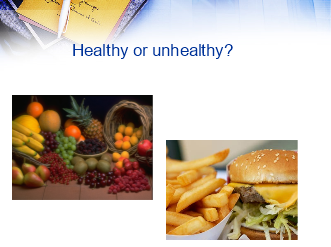
Why do people eat fast food or junk food?

Why should people eat healthy food?

What can you say about junk food?
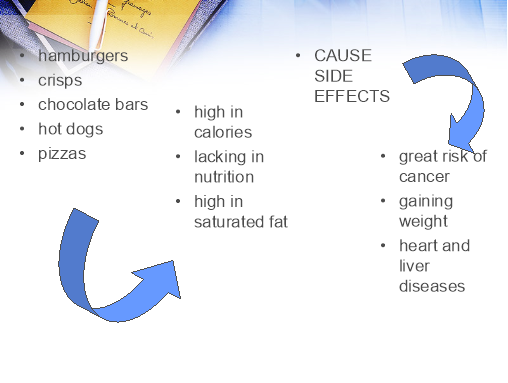
T: So, what food do you prefer?
II. ОCНОВНА ЧАСТИНА УРОКУ
Check on Homework 1. Перевірка домашнього завдання.
T: Well let’s check up your homework.You know that almost every country has its own cuisine and what is more some popular dishes are associated with this or that national cuisine. Some pupils had to prepare short reports about famous national cuisines. Let’s listen to them. (Reports about cuisines.)
Speaking 2. Розвиток комунікативних навичок
T: We have invited few students from abroad to tell us about their national dishes.
We have just learnt about some popular cuisines. What are their names? Food of
what country would you like to try?
Т: With which country do you associate the following food and drink?
|
a) Brazil / Columbia |
||
|
2) borscht |
b) Japanese |
||
|
3) hamburgers |
c) Ukraine |
||
|
4) coffee |
d)Italy |
||
|
5) gazpacho |
e) Turkey |
||
|
6) sushi |
f) England |
||
|
7) spaghetti |
g) India |
||
|
8) chicken curry |
h)France |
||
|
9) kebabs |
i) the USA |
||
|
10) champagne |
j) Spain |
Key: 1 f; 2 c; 3 i; 4 a; 5 j; 6 b; 7 d; 8 g; 9 e; 10 h.
Vocabuary Practice 3. Актуалізація опорних знань учнів.
- T: Look at the screen. Your task is to complete the sentences
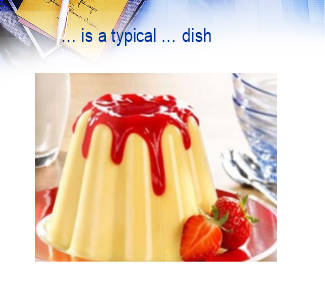
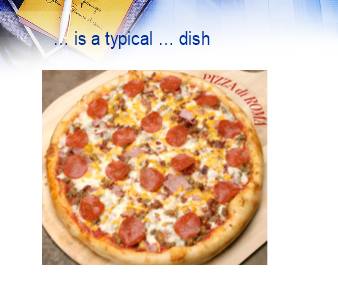
Pizza is a typical Italian dish Pudding is a typical English dish.
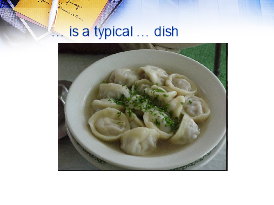
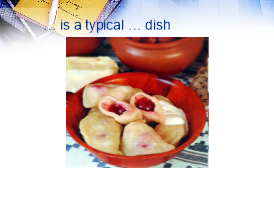 Pelmeni is a typical Russian dish. Varenyky is a typical Ukrainian dish.
Pelmeni is a typical Russian dish. Varenyky is a typical Ukrainian dish.

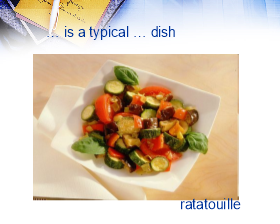
Burrito is a typical Mexican dish. Ratatouille is a typical French dish.
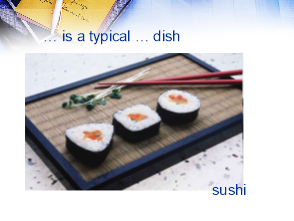
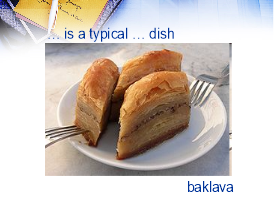
Baklava is a typical Turkish dish. Sushi is a typical Japanese dish.
T: That is great.
Grammar Revision 4. Повторення та систематизація граматичного матеріалу
T: As I have said at the beginning of the lesson we have got some grammar exercises. It is the 2- d Conditional. Tell me, please, when do we use the 2-d Conditional? How do we form it?
And now let’s do some exercises.





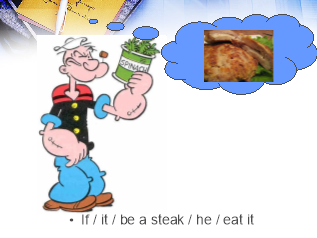
T: You have got some cards on your desk. Your task is to complete the sentences by changing the verbs in brackets to make 2-d Conditional.
|
|
ІІІ. ЗАКЛЮЧНА ЧАСТИНА УРОКУ
Homework 1. Домашнє завдання.
T: Write the dialogues about Ukrainian cuisine. Work with the cards:
|
Read and complete the sentences with the names of dishes from the box. pechenya holubtsi kvas deruny studynets mlyntsi varenyky uzvar pampushky borshch 1. … – beet soup often made with meat. 2. … – boiled dumplings stuffed with fruit, potatoes, cheese and cabbage. 3. … – cabbage rolls stuffed with millet or minced meat with rice. 4. … – crepes served with meat, cheese, fruit or caviar. 5. … – roast pork, lamb, beef or veal. 6. … – jellied meat or fish. 7. … – potato fritters served with sour cream or cottage cheese. 8. … – fried dough, similar to doughnuts. 9. … – a drink made from bread with a sweet-sour taste. 10. … – dried or fresh fruit drink. |
Summarizing 2. Підведення підсумків уроку.
Бесіда в режимі T→P 1 →P 2 →P 3.
T: What topic did we practise at the lesson today? What new information have you learned about? Your marks are….
Cl. Thank you teacher. Goodbye!


про публікацію авторської розробки
Додати розробку
